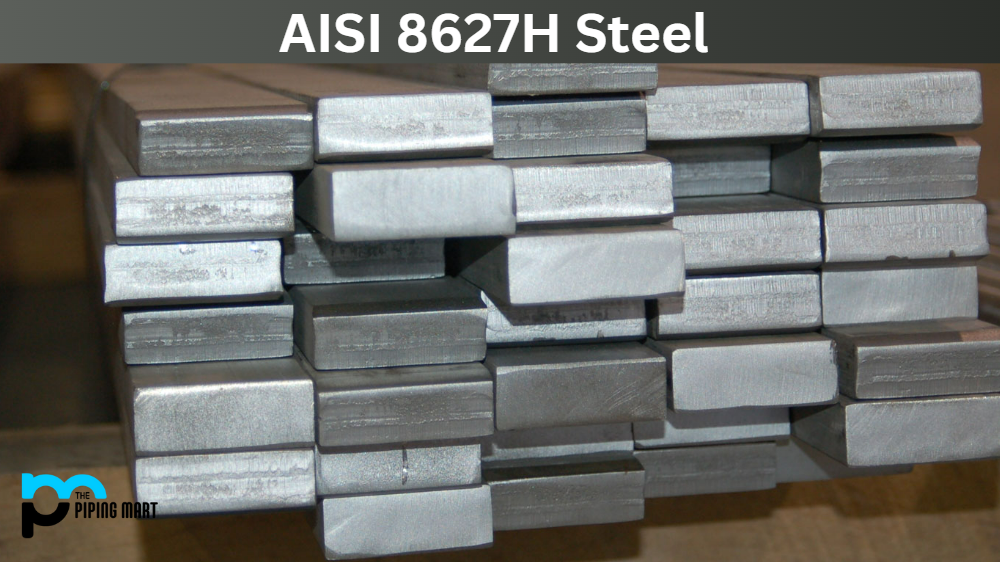When choosing the right type of steel for your construction or manufacturing projects, it can take time to decipher which one is the best fit. One type of steel that has been gaining popularity in recent years is AISI 8627H. This medium carbon alloy steel is known for its excellent strength and durability, making it a popular choice for industries such as aerospace, automotive, and oil and gas. This blog post dive into the composition, mechanical and physical properties, uses, corrosion resistance, heat treatment, machining, and welding of AISI 8627H steel.
AISI 8627H Steel Composition
AISI 8627H steel is an alloy steel that contains carbon, manganese, chromium, nickel, molybdenum, and silicon. The carbon content in AISI 8627H is about 0.27-0.33%, and the presence of nickel and molybdenum in this alloy steel enhances its strength and toughness. The manganese content contributes to its hardenability, and the chromium content improves its corrosion resistance.
| Element | Content (%) |
|---|---|
| Iron, Fe | 96.72 – 98.16 |
| Manganese, Mn | 0.600 – 0.950 |
| Nickel, Ni | 0.350 – 0.750 |
| Chromium, Cr | 0.350 – 0.650 |
| Carbon, C | 0.240 – 0.300 |
| Silicon, Si | 0.150 – 0.300 |
| Molybdenum, Mo | 0.150 – 0.250 |
| Sulfur, S | ≤ 0.0450 |
| Phosphorous, P | ≤ 0.0350 |
AISI 8627H Steel Mechanical Properties
AISI 8627H steel exhibits excellent mechanical properties, including high tensile strength, good impact resistance, and superior fatigue strength. In the normalized and tempered condition, the tensile strength of AISI 8627H steel is around 115 ksi, while its yield strength is approximately 85 ksi. Its elongation is about 20%, and its reduction in area is about 45%.
| Properties | Metric | Imperial |
|---|---|---|
| Bulk modulus (typical for steel) | 140 GPa | 20300 ksi |
| Shear modulus (typical for steel) | 80 GPa | 11600 ksi |
| Elastic modulus | 190-210 GPa | 27557-30458 ksi |
| Poisson’s ratio | 0.27-0.30 | 0.27-0.30 |
| Hardness, Brinell (annealed and cold drawn) | 179 – 223 | 179 – 223 |
| Hardness, Knoop (converted from Brinell hardness) | 223 | 223 |
| Hardness, Rockwell B (converted from Brinell hardness) | 93 | 93 |
| Hardness, Rockwell C (converted from Brinell hardness. Value below normal HRC range, for comparison only) | 13 | 13 |
| Hardness, Vickers (converted from Brinell hardness) | 211 | 211 |
| Machinability (annealed and cold drawn. Based on AISI 1212 steel. as 100 average machinability) | 60 | 60 |
AISI 8627H Steel Physical Properties
AISI 8627H steel has a density of 7.85 g/cm³ and a melting point of 1416°C (2581°F). Its thermal conductivity is around 44.5 W/mK, and its specific heat capacity is approximately 477 J/kgK. The coefficient of thermal expansion of AISI 8627H steel is about 11.7 µm/m°C.
| Properties | Metric | Imperial |
|---|---|---|
| Density | 7.85 g/cm3 | 0.284 lb/in³ |
AISI 8627H Steel Equivalents
- ASTM A304
- SAE J1268
AISI 8627H Steel Uses
AISI 8627H steel is widely used in various industries, including aerospace, automotive, and oil and gas. Its excellent durability and strength make it ideal for manufacturing critical components such as gears, shafts, and axles. It is also used in high-stress applications such as springs, piston rods, and hydraulic components.
AISI 8627H Steel Corrosion Resistance
AISI 8627H steel offers moderate to good resistance to corrosion. The chromium content in this alloy steel enhances its resistance to oxidation, while the nickel and molybdenum content improves its resistance to pitting and crevice corrosion. However, it is still susceptible to corrosion in aggressive environments, such as saltwater and acidic solutions.
AISI 8627H Steel Heat Treatment
AISI 8627H steel can be heat treated to achieve various hardness and strength levels. The recommended heat treatment for this alloy steel is quenching and tempering. The quenching process involves heating the steel to around 830°C (1525°F) and then rapidly cooling it in water or oil. The tempering process consists in reheating the steel to a temperature between 375-500°C (705-930°F) to achieve the desired level of hardness and strength.
AISI 8627H Steel Machining
AISI 8627H steel exhibits good machinability properties when annealed, normalized, and tempered. However, it is essential to note that this alloy steel tends to work and harden quickly, so proper cutting speeds and feeds are necessary to avoid damaging the cutting tools.
AISI 8627H Steel Welding
AISI 8627H steel can be welded using various welding techniques, including Gas Tungsten Arc Welding (GTAW), Gas Metal Arc Welding (GMAW), and Shielded Metal Arc Welding (SMAW).
However, preheating the steel before welding is essential to avoid cracking and brittleness.
Conclusion
AISI 8627H steel is an excellent choice for those seeking high-strength, durable alloy steel for their manufacturing needs. Its impressive mechanical properties and moderate corrosion resistance make it well-suited for critical aerospace, automotive, and oil and gas applications. With its exceptional machinability and weldability, AISI 8627H steel is a versatile choice for various uses, from gear manufacturing to hydraulic components. Overall, AISI 8627H steel is a reliable and robust choice with superior quality and performance.

Hey, I’m Krutik, a casual blogger expert in the metal industry. I am passionate about providing valuable information to my readers. With a background in engineering and construction, I like playing Cricket & watching Netflix shows in my free time. Thank you for visiting my blog, and I hope you find my information helpful!




